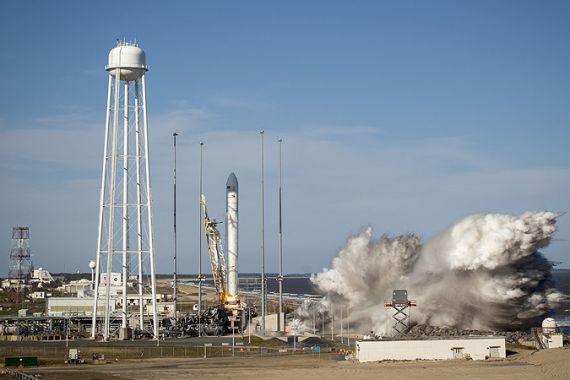Private US rocket Antares makes test flight
Orbital Sciences’ co-launch with NASA from Virginia spaceport paves way for cargo flight to International Space Station.

A privately owned rocket built in partnership with NASA to haul cargo to the International Space Station (ISS) has blasted off for a debut test flight from a new commercial spaceport in Virginia.
The 13-story Antares rocket, developed and flown by Orbital Sciences Corporation, left on Sunday.
NASA Administrator Charles Bolden said in a written statement the “picture-perfect” launch of the Antares rocket provided further evidence that the space agency’s strategic exploration plan was moving forward.
“This test also inaugurates America’s newest spaceport capable of launching to the space station, opening up additional opportunities for commercial and government users,” Bolden said.
Orbital Sciences and privately owned Space Exploration Technologies, or SpaceX, hold NASA contracts valued at a combined $3.5bn to fly cargo to the space station, a $100bn research outpost that flies about 400km above Earth.
NASA turned to commercial suppliers after retiring the space shuttles in 2011.
Space station run
Citing the Antares test, David Thompson, chairman of Orbital Sciences, said that the Virginia-based company planned to build on the two-stage launch vehicle’s success with a demonstration run to the space station with its Cygnus capsule.
“We will now move forward toward completing the full demonstration mission of our system to resupply the International Space Station with essential cargo in just a couple of months,” Thompson said.
That flight is scheduled for late June or early July.
A $1.9bn contract requires Orbital Sciences Corporation to deliver freight to the ISS over the course of eight flights by the beginning of 2016.
Unlike the Dragon capsule, developed by rival SpaceX, Cygnus cannot return to Earth and will be destroyed upon re-entry after its mission is complete.
However, Orbital Sciences said Cygnus could stay in orbit for a year.
Dummy capsule
The Antares rocket left at 5pm local time (21:00 GMT) to cheers of delight from scientists at the Virginia-owned and operated launch pad at NASA’s Wallops Flight Facility on Wallops Island.
“Beautiful view,” said NASA launch commentator Kyle Herring as live video from the rocket, broadcast on NASA TV, showed the booster riding atop a bright plume of fire above the Atlantic Ocean.
Ten minutes later, the rocket deposited its payload, a 3,800kg dummy capsule, into an orbit 254km above Earth, fulfilling the primary goal of the test flight.
Flight controllers radioed news of the rocket’s successful debut to the station crew shortly after launch.
“Wahoo, that’s super,” replied station commander Chris Hadfield, with the Canadian Space Agency. “That bodes well for all of our futures.”
California-based SpaceX completed three test flights and last year began delivering cargo to the station under its $1.6bn contract.